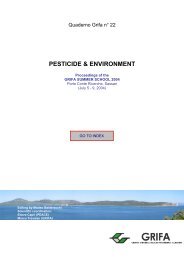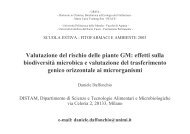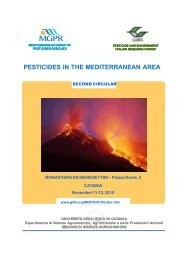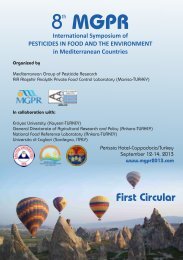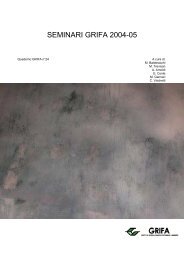International Congress BIOLOGICAL PRODUCTS - Gruppo di ...
International Congress BIOLOGICAL PRODUCTS - Gruppo di ...
International Congress BIOLOGICAL PRODUCTS - Gruppo di ...
Create successful ePaper yourself
Turn your PDF publications into a flip-book with our unique Google optimized e-Paper software.
36<br />
NEW α-ELICITIN ISOFORMS FROM Phytophthora hybernalis AS PROTEIN ELICITORS FOR A<br />
POTENTIAL EMPLOYMENT IN THE <strong>BIOLOGICAL</strong> PEST MANAGEMENT<br />
R. Capasso*, A. De Martino*, G. Cristinzio**, A. Di Maro*** and A. Parente***<br />
*Dipartimento <strong>di</strong> Scienze della Pianta, del Suolo e dell’Ambiente, Università degli Stu<strong>di</strong> <strong>di</strong> Napoli “Federico II”,<br />
Portici, Italy. E-mail: capasso@unina.it<br />
** Dipartimento <strong>di</strong> Arboricoltura, Botanica e Patologia Vegetale, Università degli Stu<strong>di</strong> <strong>di</strong><br />
Napoli “Federico II”, Portici, Italy.<br />
*** Dipartimento <strong>di</strong> Scienze della Vita, Seconda Università degli Stu<strong>di</strong> <strong>di</strong> Napoli, Caserta, Italy.<br />
The microbial naturally occurring compounds which are able to induce plant defence mechanisms against<br />
phytopathogenic fungi and bacteria are named elicitors and could be consequently employed in strategies for the<br />
biological control of plant <strong>di</strong>seases.<br />
The genus Phytophthora produces protein elicitors, named α- and β-elicitins, which show a relative molecular weight<br />
of 10 KDa and 98 amino acids. Their characteristic biological activities are the induction of a hypersensitive response<br />
(HR) and systemic acquired resistance (SAR) in tobacco with the formation of phytoalexins, PR proteins and salycilic<br />
acid; moreover, they induce protection against phytopathogenic microorganisms in tobacco and in some species of<br />
Brassicaceae 1 .<br />
In the present communication we describe the isolation and the preliminary data on the chemical characterization and<br />
elicitor activity on tobacco (Nicotiana tabacum L., cv Rustica) of three new elicitin isoforms H-α1, H-α2 e H-α3,<br />
produced in the culture filtrates of an isolate of Phytophthora hybernalis, the causal agent of rot of citrus fruits, isolated<br />
from <strong>di</strong>seased plants in the sorrentina peninsula.<br />
The three isoforms have been isolated by four purification steps, of which the final step was represented by a<br />
chromatographic purification on a reverse-phase column (RP-18) eluted at low pressure with a gra<strong>di</strong>ent of wateracetonitrile.<br />
It was determined their absolute molecular weight by MALDI Mass Spectrometry, obtaining values of 10239.24 for Hα1,<br />
10235.94 for H-α2 and 10244.28 uma for H-α3.<br />
In stu<strong>di</strong>es of elicitor activity carried out testing the hypersensitive response on tobacco, the three isoforms showed<br />
<strong>di</strong>fferent intensity responses, that is H-α1 proved to be the most active, followed by H-α2, whereas H-α3 proved to be<br />
inactive.<br />
Stu<strong>di</strong>es will be carried out on the determination of their primary structure and elicitor effects on other plants of<br />
agricultural interest. The very low dose required for their positive biological effects on tobacco, their protein nature<br />
and the no toxicity of the elicitins for adults 2 , render these new compounds and those previously described 1,3,4 very<br />
interesting for investigations on their possible use in biological pest management programs.<br />
REFERENCES<br />
1. Ponchet, M., Panabieres, F., Milat, M.-L., Mikes, V., Montillet, J.-L., Suty, L., Triantaphylides, C.,<br />
Tirilly, Y., Blein, J.-P., 1999. Are elicitins cryptograms in plant-Oomycete communications? Cell Mol.<br />
Life Sci. 56, 1020-1047.<br />
2. Mikes, V., Blein, J.-P., Milat, M.-L., Ponchet, M., Ricci, P., 1998. Use of elicitins as lipid carriers<br />
and their me<strong>di</strong>cal use. Patent PCT Int. Appl. 31 pp Coden; PIXXD2.<br />
3. Capasso, R., Cristinzio, G., Evidente, A.,Visca, C., Ferranti, P., Del Vecchio Blanco, F., Parente, A.,<br />
Elicitin 172 from an isolate of Phytophthora nicotianae, pathogenic to tomato. Phytochem. 50,<br />
703-709.<br />
4. Capasso, R., Cristinzio, G., Di Maro, A. Ferranti, P., Parente, A., 2001. Syringicin a new α-elicitin from<br />
an isolate of Phytophthora syringae, pathogenic to citrus fruit. Phytochem. 58, 257-262.<br />
PDF creato con FinePrint pdfFactory versione <strong>di</strong>mostrativa http://www.secom.re.it/fineprint<br />
158



